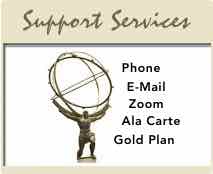TuneTracker™ QuickTip
Get these all the time! Write to us and we'll add you to our weekly e-mail tiplist. Streaming Tips, Part I
Streaming Tips, Part I
Webcasting! It can be used so many ways to reach so many different audiences. Whether you're a major corporation training remote staff, a high-profile Internet music broadcaster, or a hobbyist playing music for your friends, webcasting is rewarding, effective, and just plain fun.
In this series of Q-Tips articles, we'll cover some of the basics of webcasting. It isn't intended to take the place of our documentation or a serious personal investigation of the subject, but it will definitely help those who are new to the subject to get off to a good start.
First off, let's clear up a common source of confusion. The bitrate at which files are *recorded* should not be confused with the streaming bitrate at which you broadcast an Internet stream. Both are a measurement of bits-per-second of information, and thus of audio quality, but that is the extent of their association.
When you create an MP3 file, for example, you might be dealing with a 16 bit stereo file recorded at a sample rate of 44.1 khz and then encoded to MP3 at 160 kbps. Confused by all those numbers? We don't blame you. Suffice it to say, they're related to the quality at which a particular file was initially recorded, and the quality that was used as it was converted to MP3. In the TuneTracker System, you can mix and match lots of different audio files recorded in both compressed and uncompressed formats, but as TuneTracker broadcasts them, it turns them into a single kind of audio signal for playback, and all that fancy-schmancy information is gone and forgotten in favor of...sound.
As all these files, regardless of their original quality characteristics, are played back through the TuneTracker System, they are converted to a single continuous audio signal. That signal can be broadcast over the air, over the Internet, or both simultaneously. If you set things up for Internet broadcasting, you will be converting that audio signal into a stream of data. The quality of that signal is determined in large part by the streaming bitrate you choose.
The streaming bitrate is a measurement of how many thousands of bits per second you opt to transmit at. As you might suspect, the higher the number you choose, the better the quality will be. The payoff, of course, is that both you and your listeners must have greater bandwidth (Internet speed) capacity to support a higher streaming bitrate.
As a result, it's important for you to identify your audience by age, quality expectations, and affluence (how many will have high-bandwidth connections). Additionally, consider the content you are broadcasting. If your listeners are tuning in for news and talk information, you can justify keeping your streaming bitrate lower, like 12 kbps, 16 kbps, or 24 kbps. If you're music-intensive and playing to a demanding, affluent audience, you might not be able to get by with less than 64 kbps or even 128 kbps
In general, a 56k dialup listener can only be expected to be able to stay reliably connected to a 16 kbps (kilobits per second) stream. A 16 kbps stream could best be compared to the quality of an A.M. radio. At that bitrate, we definitely do not recommend you attempt stereo, because you'll be using half of the data stream (8 kbps) for each half of the stereo signal, and the result will be half the audio quality. That same thing holds true at all bitrates, but the lower ones suffer the most in the attempt.
A cable-connected or ADSL-connected listener can handle a lot more bandwidth, allowing you to send considerably better-quality signals. Stereo signals at 56 kbps, 64 kbps, and even higher, are possible.
The other question that needs answering, of course, is how much bandwith do you have at your station's disposal? Since each listener grabs bandwidth equal to your streaming bitrate, a little quick math will tell you how many listeners you can handle. Consider that on a DSL connection with an upstream (sending) capacity of 256 kbps, you can potentially send out 25 8 kbps streams, twelve 16 kbps streams, and only two 128 kbps streams. Since these numbers are only theoretical, and Murphy's Law plays a part, your actual listener numbers will probably be even lower.
If you're broadcasting to a few friends, or you're sitting on top of a T1, T2, or T3 backbone connection somewhere and have all the bandwidth you need for a larger listenerbase, you're all set. However not everybody fits into one of those two categories. Some have much greater listener aspirations than their personal connectivity would ever permit them to reach. In our next article, we'll cover some of the ways you can send a single stream out from your computer and have it rebroadcast to many listeners through a third party restreaming service.